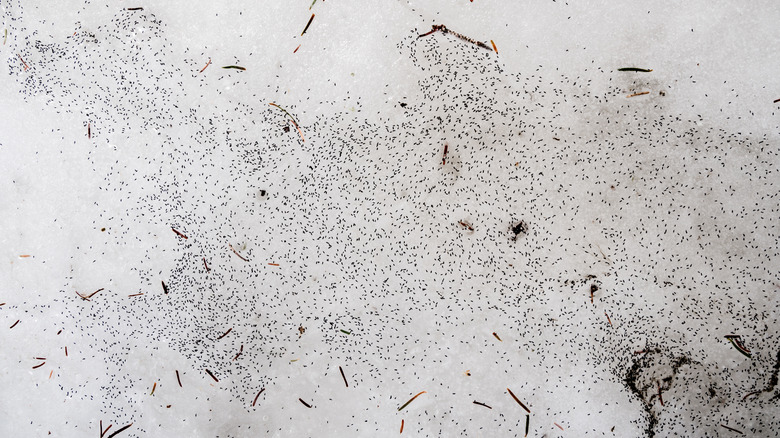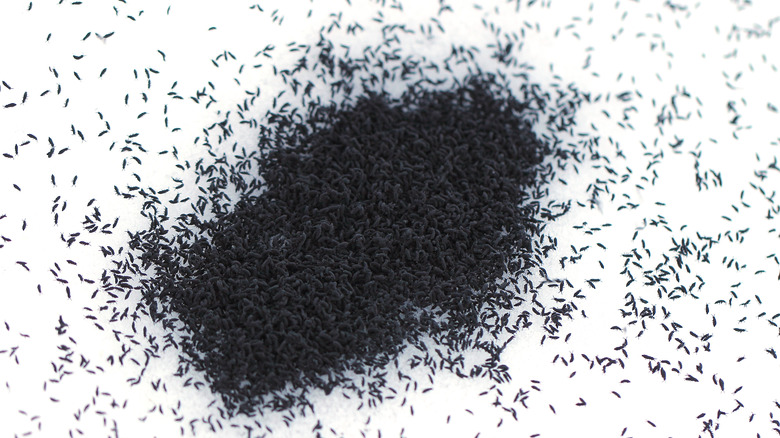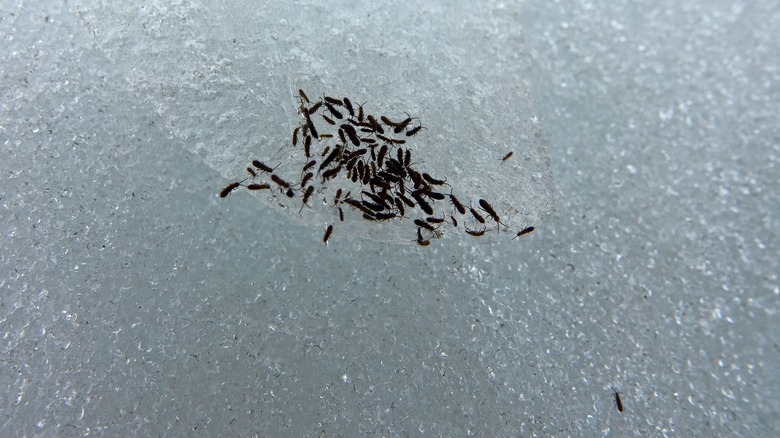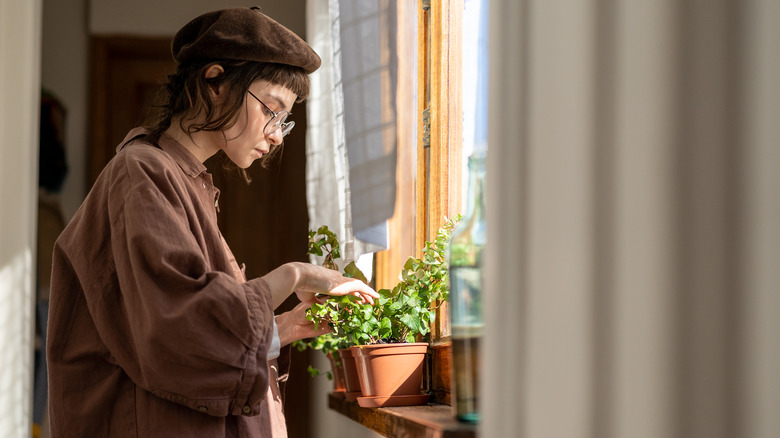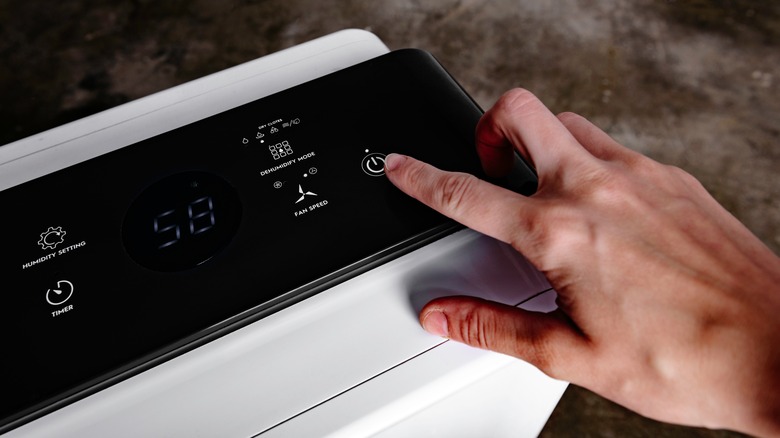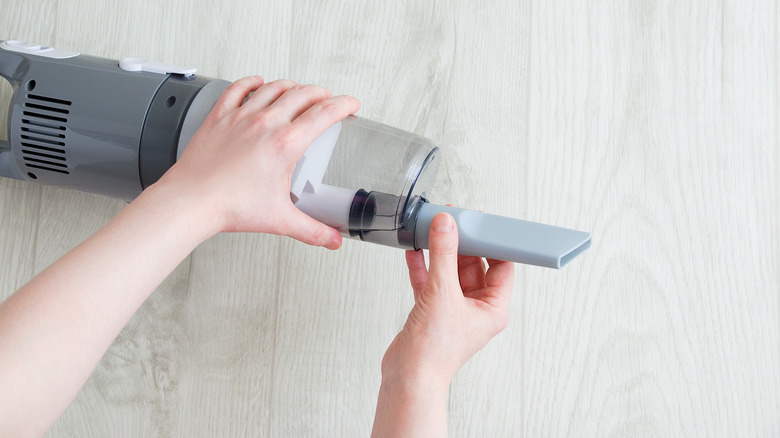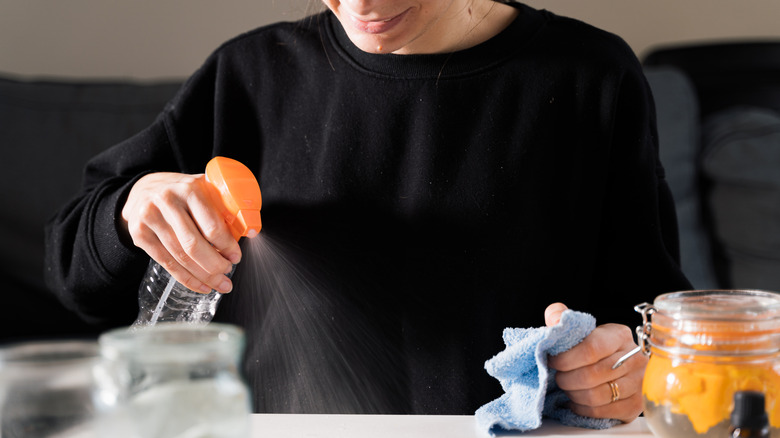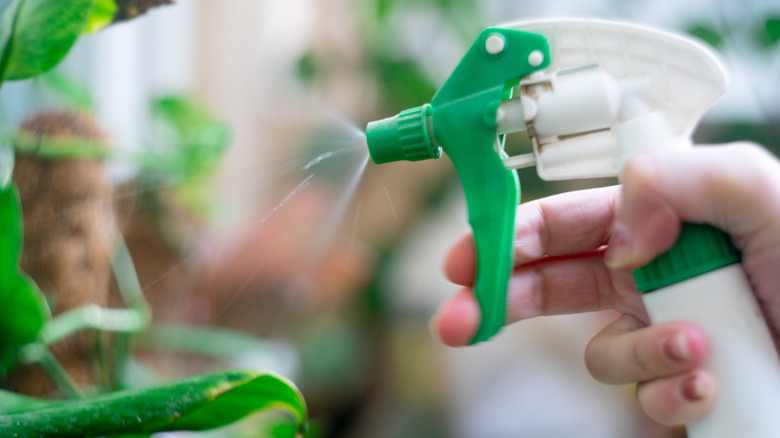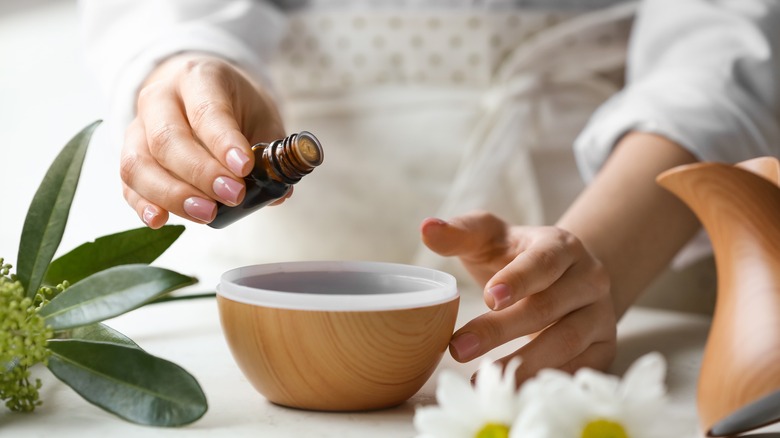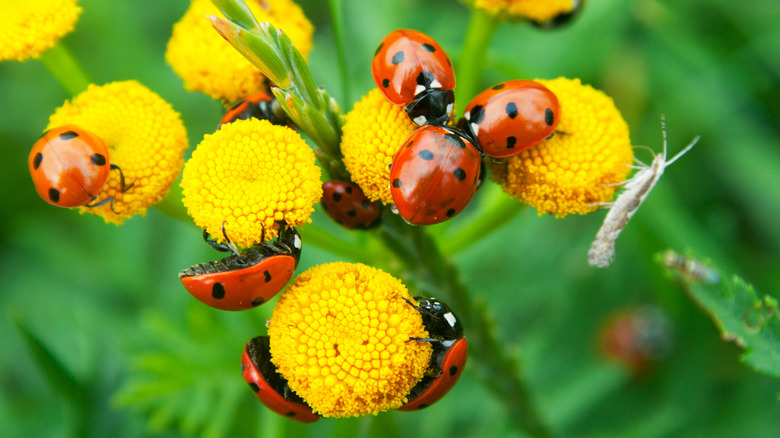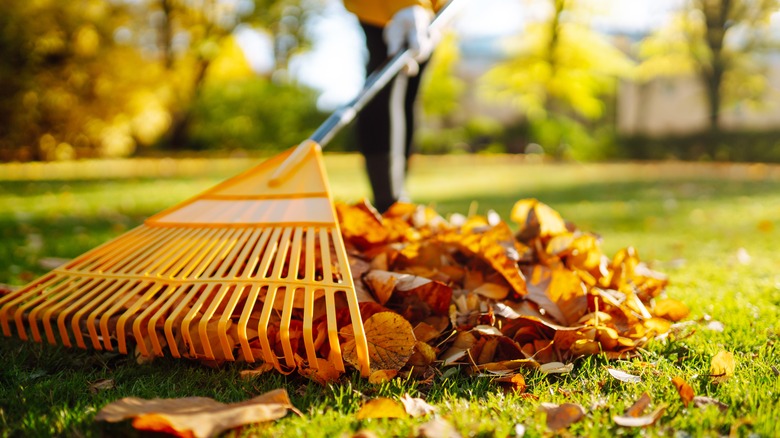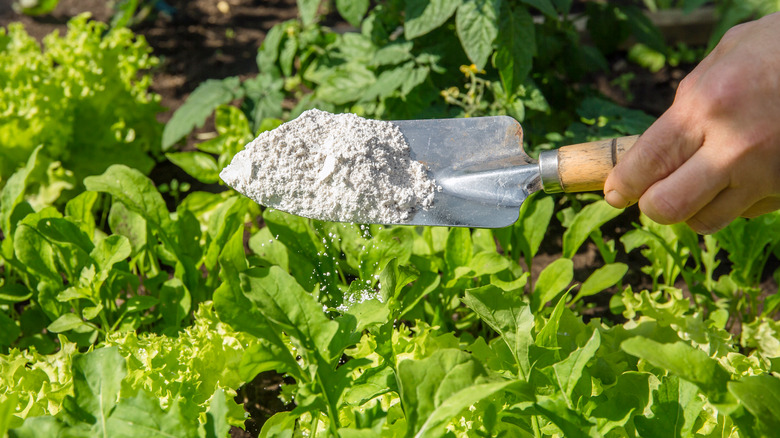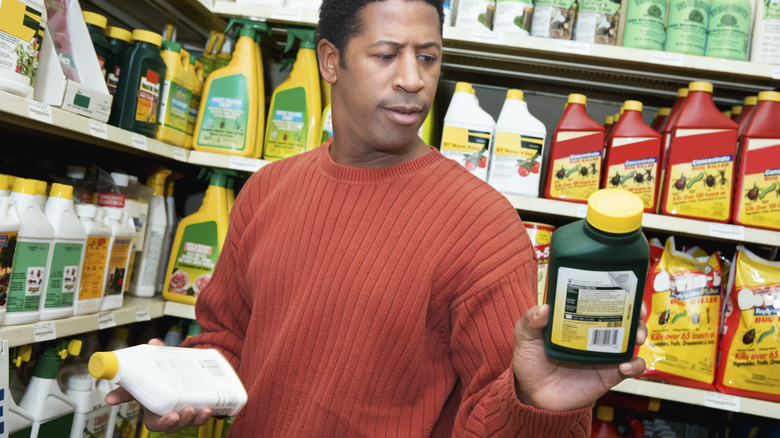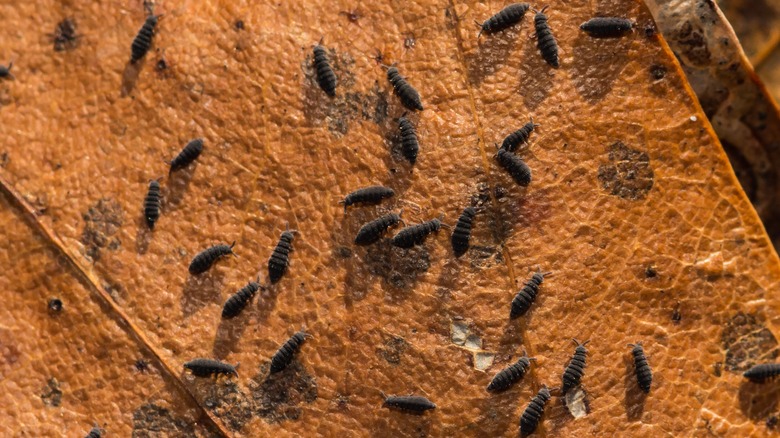How To Identify And Get Rid Of A Snow Flea Infestation
We may receive a commission on purchases made from links.
There's nothing more exciting in winter than romping around in the snow. As your kids build forts and make snow angels, or you shovel the driveway, you may notice the snow under your feet begin to turn black. What you're likely seeing are tiny hexapods called snow fleas (Hypogastrura nivicola). Snow fleas are not traditional fleas like you'd see on a dog or cat, but rather small-scale creatures from the arthropod family. Although snow fleas can jump, they do not bite and pose no danger to humans or family pets.
Snow fleas are beneficial, as they feed on fallen leaves, dead insects, and fungi. So, they don't become pests until they enter your home. You may spot them on the plumbing in your bathroom or kitchen, as well as in the soil of your houseplants. Once you've positively identified the bugs, you'll need to take action to remove them. After successfully eliminating the snow fleas, you can utilize a few prevention strategies to keep them from entering your dwelling again in the future.
What exactly are snow fleas?
Snow fleas aren't actually fleas, but rather a species of springtails. They have oval-shaped soft bodies with a set of antennas and six legs. It's the tail of the snow fleas that sets the creature apart, as it is equipped with a furcula that makes it possible for the tiny hexapods to jump around. The furcula remains tucked under the snow flea's body. When it's released, the springtails can jump from one location to another. In fact, even though the snow fleas are minuscule in size, they are capable of leaping a few inches at a time.
The furcula isn't the only thing that differentiates snow fleas from some other insects. The springtails also feature an antifreeze-like protein in their make-up, which allows them to survive in cold temperatures. Instead of entering a state of dormancy, you'll find the snow fleas actively enjoying winter's white blanket. Their ability to stay alive and reach the top of a snow pile is how they got their name.
Identifying snow fleas in your snow-covered landscape
Snow fleas are tiny, wingless creatures that appear black when they make their way to the top of the snow, which they tend to do late in the winter season. Many experts describe them as resembling the spice pepper. Since snow fleas are approximately 1/10-inch long and live within the soil during the summer months, you won't spot them until winter arrives. Their bodies are elongated and flattened on the sides, but you don't need a microscope to identify them. Simply keep your eyes on the snow and you'll see a large group of tiny dark specks moving around.
Although you can find snow fleas just about anywhere on your property, they are often spotted surrounding trees and areas of excessive moisture. Snow fleas also have a love for maple syrup. That means if your property has an infestation of these hexapods, you're likely to find them feasting on this natural sweetener.
Spotting snow fleas indoors
Once snow fleas make their way indoors, they aren't hard to locate. This is because the hexapods tend to congregate in groups in spaces that are damp or humid. Just like outdoors, when you spot the snow fleas, you'll notice them jumping and moving around. It's important to note that left unchecked, snow fleas will multiply quickly. So where should you begin searching for the tiny bugs?
Start in the kitchen, where you'll want to examine the sink and dishwasher, as well as their related plumbing. If you have any houseplants or planter boxes by the windowsill, check them too. Next, head on over to the bathroom and perform a full inspection. Bathrooms are humid, so the snow fleas could be there as well. Then, move on to the basement, and make sure you look all around the perimeter. Utility closets that house washing machines will also need to be examined. Depending on the season, you may even find snow fleas in your attic.
Control moisture to prevent snow flea infestations
In order to prevent snow fleas from becoming a problem within the home, you'll need to take measures to increase ventilation and decrease humidity. This is because the tiny pests are drawn to excessive moisture. When their preferred outdoor environment begins to dry out, they may make their way indoors in search of a water source.
Use a dehumidifier to reduce the overall moisture level within the home, especially within a damp basement or humid attic. Check plumbing fixtures for leaks and make any necessary repairs. When it comes to houseplants, you can prevent infestations in the soil by not overwatering. Ensure front porches, back decks, and crawl spaces have proper ventilation. Then, take a look at your landscape. If you have any slopes that are directing water toward your foundation, you'll want to even them out. A professional landscaper can help you improve your yard's drainage if the slopes are steep.
Remove snow fleas easily by hand
You can eliminate snow fleas from the home by scooping them up or by vacuuming them with a hose attachment. However, pest-infested houseplants will need to be repotted. Carefully remove the plant from the soil and then dump the affected soil into a garbage bag. Tie the bag up tight and set it in an outdoor trash can. Clean the flower pot thoroughly before filling it back up with the appropriate potting mix. Then, gently rinse off the plant's roots before transferring it back to the flower pot.
Snow fleas in other areas within the home can be removed using your household vacuum. Attach either a crevice tool or a long tension rod to the vacuum's hose and suck up all the tiny bugs you see. Once you're sure you've collected all of the fleas, immediately remove the vacuum cleaner bag and toss it in a garbage bag. Tie the bag tight and then place it in an outdoor trash can. If your vacuum is bagless, make sure you wash out the collection container after dumping the contents into the garbage bag.
Eliminate snow fleas using household vinegar
There's no need to introduce harmful chemicals to your living space, as common household ingredients can successfully exterminate snow fleas. Vinegar repels the pests and one with an acidity of 10 percent is your best bet, as apple cider vinegar isn't as strong and can be quite odorous. In addition to killing snow fleas on contact, the vinegar will also act as a natural repellent, so it's a win-win!
Grab a spray bottle and fill it with the white distilled vinegar. Begin spraying all of the snow fleas you locate within your home. Afterward, you'll be able to wipe up the dead hexapods with a damp paper towel. Before putting the vinegar away, consider spraying it around the perimeter of your kitchen, bathroom, and basement, which are the most common areas for snow fleas to infest. This added layer of protection will help keep the tiny bugs from returning.
Use neem oil as a natural insecticide
Another option when it comes to the control of snow fleas is neem oil. This natural insecticide contains the active ingredient azadirachtin, which works to disrupt the pest's ability to eat. Eventually, the snow fleas will die of starvation. The oil also doubles as a repellent to prevent future infestations.
Since neem oil is sold in a variety of forms, it is essential that you read all product labels carefully. The first thing you'll want to do is look for the formula that is listed as effective against fleas, like Bonide's Neem Oil spray from Lowe's. Next, review how the neem oil is to be properly dispensed. Pay attention to all safety guidelines, such as wearing gloves and a mask during application and avoiding areas where pets and children play. If your houseplants are infested, neem oil can be added to warm water and then mixed with a few drops of liquid dish soap to create a homemade insecticidal soap.
Repel future snow fleas with cedar oil
With cedar oil, also sometimes referred to as cedarwood oil, you get the best of both worlds. You'll enjoy a natural insecticide that kills on contact, as well as a repellent. It doesn't hurt that the oil also has a sweet woody scent that will leave your home smelling like fresh pine trees. Cedar oil is safe to use in homes with pets and children and can be administered using several different methods.
Create an insecticidal spray by mixing 1 ounce of cedar oil with 6 ounces of water. Use the spray anywhere you spot snow fleas. Should you wish to prevent a snow flea infestation, add 10 drops of cedar oil to your diffuser and set it in a room that tends to harbor moisture. Some pest control companies recommend adding cedar oil to a fog machine to treat a larger area of the home, as well as the home's air ducts.
Introduce natural predators to control snow flea infestations
Biological control is another excellent course of action worth implementing to eliminate outdoor snow flea infestations, although this option works a bit slower than all of the above-mentioned methods. You can order a package of adorable ladybugs on Amazon. Introducing these spotted friends to your landscape is ideal, as they are known to feast on springtails and other soft-bodied insects without harming vegetation or becoming a nuisance to homeowners. You'll need approximately 1,500 ladybugs for every 1,000 square feet of land.
Stratiolaelaps scimitus are tiny predatory mites that can be used in place of ladybugs to eradicate snow fleas. They are also effective against fungus gnats and can be ordered from Sound Horticulture. Although the mites won't control current adult springtail populations, they will dine on their larvae. That means you can deter snow flea infestations, as the larvae fail to reach the adult stage. For about 1,000 square feet of land, you'll need to release about 5,000 stratiolaelaps scimitus mites.
Clean up outdoor debris
One of the biggest ways to prevent a springtail infestation is to make the habitat less attractive. This begins with a survey of your property. Since snow fleas feast on decaying matter, locate any piles of organic debris and clean them up. Move stacks of firewood as far away from your house as you can. If you're using wood chips as mulch, remove them and opt for landscape fabric, rocks, or rubber mulch instead. These non-organic mulches will provide your plants with the winter protection they need without drawing the attention of springtails.
Snow fleas also munch on fungi and algae, so you'll need to create a dryer environment. During the summer months, consider allowing your lawn to dry out in between waterings. Take care not to overwater flower and vegetable gardens, and remove any standing water. This includes bringing any pet water bowls left on a back porch or patio inside and checking outdoor hoses for leaks.
Treat the yard with diatomaceous earth
When it comes to preventing snow fleas from entering your house, an application of diatomaceous earth around the perimeter can be useful. This non-toxic powder is a form of silicon dioxide and it works by piercing the soft bodies of the snow fleas who come into contact with it. This causes their bodies to dehydrate, which leads to the death of the springtails. Diatomaceous earth is safe to use around dogs and cats and is also effective against other pests, including mites, bed bugs, and spiders.
Grab a bag of food-grade diatomaceous earth and begin sprinkling it around the border of your home. A thick, even layer all the way around is needed, so the fleas don't have a path into the home without first stepping on the powder. It's important to note that rain can dilute and wash away the diatomaceous earth, so you'll need to reapply it to refresh the barrier between your house and yard.
Avoid chemical pesticides
While it's natural to want to grab a chemical pesticide from the nearest gardening center, this likely isn't necessary when it comes to snow fleas. Organic control methods, like those mentioned above, can be effective at removing infestations from both inside and outside your home. In fact, you can combine several of the options for multi-faceted control, such as spraying white distilled vinegar on springtails in the bathroom and clearing the yard of debris and standing water.
Chemical pesticides come with risks for homes with small children and pets, as they often play outside and may come into contact with the spray. Then there's the issue of run-off, which can cause problems for aquatic life, should the chemicals reach a nearby body of water. If the infestation is strictly outdoors, consider leaving the snow fleas alone, so you can reap the benefits of richer soil.
Benefits associated with snow fleas
If your snow flea infestation is outdoors only, you'll want to consider leaving them be, as there are actually benefits to keeping the tiny creatures around. Snow fleas have a main diet of decaying organic matter, such as fallen leaves, woody material, and dead or dying plants. As the springtails work their way through the organic matter, the soil is left richer than it was before. As a result, the soil is naturally more nutrient-dense and better able to supply flowers and planted vegetables with what they need to grow and thrive come spring.
Additionally, snow fleas feast on fungi, algae, and bacteria. That means the plants in your garden are less likely to become infected with said fungi, algae, or bacteria, leaving you with a healthier crop. In fact, the experts at Farmer's Almanac point out that finding snow fleas in a landscape is an excellent indication that the environment is robust.

